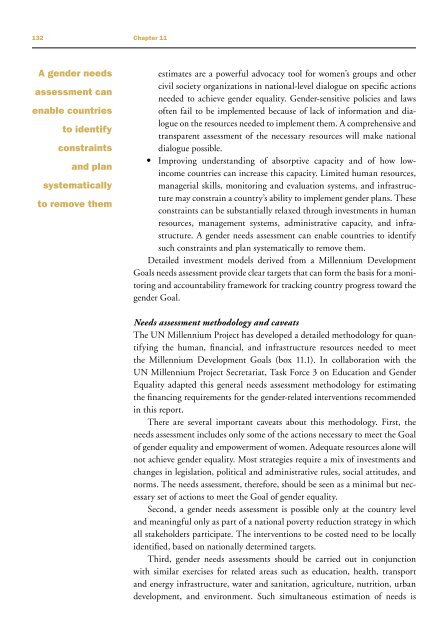Taking action: achieving gender equality and empowering women
Taking action: achieving gender equality and empowering women
Taking action: achieving gender equality and empowering women
Create successful ePaper yourself
Turn your PDF publications into a flip-book with our unique Google optimized e-Paper software.
132 Chapter 11<br />
A <strong>gender</strong> needs<br />
assessment can<br />
enable countries<br />
to identify<br />
constraints<br />
<strong>and</strong> plan<br />
systematically<br />
to remove them<br />
estimates are a powerful advocacy tool for <strong>women</strong>’s groups <strong>and</strong> other<br />
civil society organizations in national-level dialogue on specific <strong>action</strong>s<br />
needed to achieve <strong>gender</strong> <strong>equality</strong>. Gender-sensitive policies <strong>and</strong> laws<br />
often fail to be implemented because of lack of information <strong>and</strong> dialogue<br />
on the resources needed to implement them. A comprehensive <strong>and</strong><br />
transparent assessment of the necessary resources will make national<br />
dialogue possible.<br />
• Improving underst<strong>and</strong>ing of absorptive capacity <strong>and</strong> of how lowincome<br />
countries can increase this capacity. Limited human resources,<br />
managerial skills, monitoring <strong>and</strong> evaluation systems, <strong>and</strong> infrastructure<br />
may constrain a country’s ability to implement <strong>gender</strong> plans. These<br />
constraints can be substantially relaxed through investments in human<br />
resources, management systems, administrative capacity, <strong>and</strong> infrastructure.<br />
A <strong>gender</strong> needs assessment can enable countries to identify<br />
such constraints <strong>and</strong> plan systematically to remove them.<br />
Detailed investment models derived from a Millennium Development<br />
Goals needs assessment provide clear targets that can form the basis for a monitoring<br />
<strong>and</strong> accountability framework for tracking country progress toward the<br />
<strong>gender</strong> Goal.<br />
Needs assessment methodology <strong>and</strong> caveats<br />
The UN Millennium Project has developed a detailed methodology for quantifying<br />
the human, financial, <strong>and</strong> infrastructure resources needed to meet<br />
the Millennium Development Goals (box 11.1). In collaboration with the<br />
UN Millennium Project Secretariat, Task Force 3 on Education <strong>and</strong> Gender<br />
Equality adapted this general needs assessment methodology for estimating<br />
the financing requirements for the <strong>gender</strong>-related interventions recommended<br />
in this report.<br />
There are several important caveats about this methodology. First, the<br />
needs assessment includes only some of the <strong>action</strong>s necessary to meet the Goal<br />
of <strong>gender</strong> <strong>equality</strong> <strong>and</strong> empowerment of <strong>women</strong>. Adequate resources alone will<br />
not achieve <strong>gender</strong> <strong>equality</strong>. Most strategies require a mix of investments <strong>and</strong><br />
changes in legislation, political <strong>and</strong> administrative rules, social attitudes, <strong>and</strong><br />
norms. The needs assessment, therefore, should be seen as a minimal but necessary<br />
set of <strong>action</strong>s to meet the Goal of <strong>gender</strong> <strong>equality</strong>.<br />
Second, a <strong>gender</strong> needs assessment is possible only at the country level<br />
<strong>and</strong> meaningful only as part of a national poverty reduction strategy in which<br />
all stakeholders participate. The interventions to be costed need to be locally<br />
identified, based on nationally determined targets.<br />
Third, <strong>gender</strong> needs assessments should be carried out in conjunction<br />
with similar exercises for related areas such as education, health, transport<br />
<strong>and</strong> energy infrastructure, water <strong>and</strong> sanitation, agriculture, nutrition, urban<br />
development, <strong>and</strong> environment. Such simultaneous estimation of needs is

















